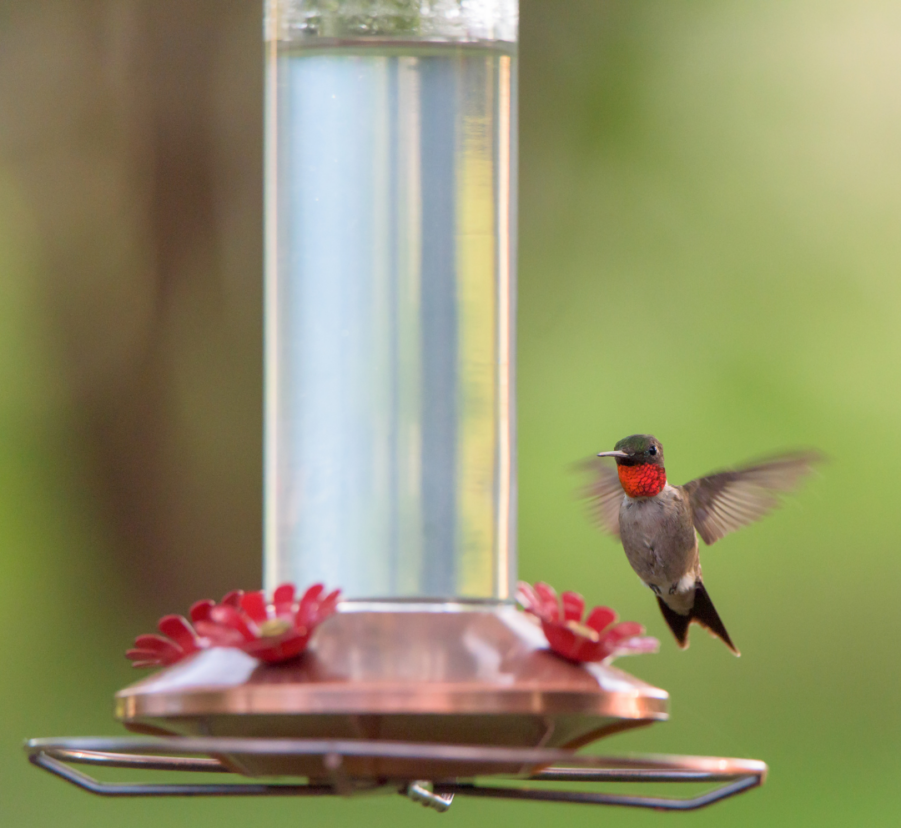Hummingbirds are no-doubt one of the most delightful groups of birds in the Western hemisphere. They’re fast, energetic, spunky, and fly like insects, achieving feats that most birds cannot. In many ways, hummingbirds also symbolize an idyllic garden scene, hovering their way from flower to flower. I tend to get one particular question when hummingbirds migrate back through North America every spring. How can I attract hummingbirds to my yard?
In this Naturalist Answers post, we’ll explore how to attract hummingbirds to your outdoor spaces.
For starters, let’s talk about habitat. Habitat is a word that naturalists use to describe outdoor places at the local (smaller) scale. If you’re Gardening for Wildlife, then you’re making your own outdoor spaces into a habitat. What kind of wildlife you want to attract determines what sort of habitat you’d like to create, and how you go about it. So…
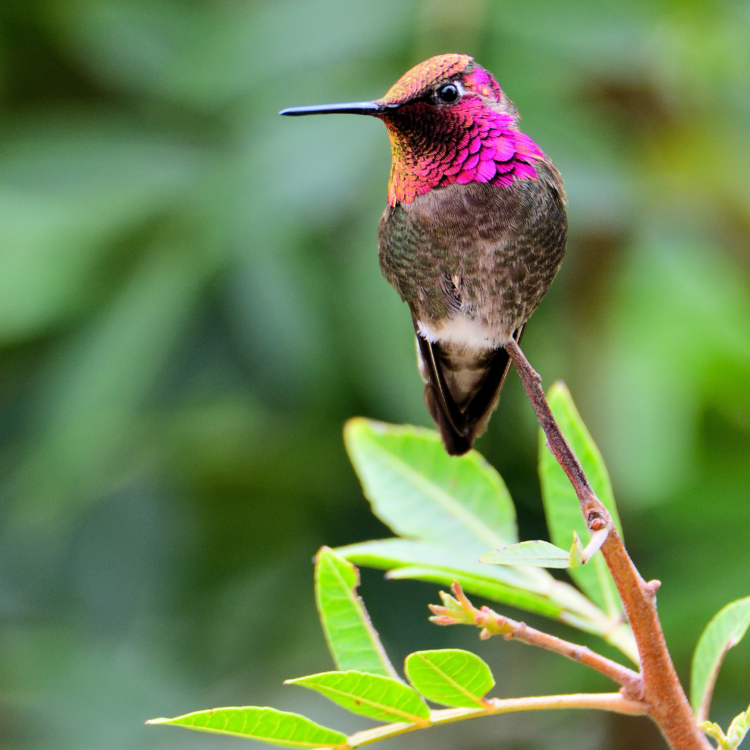
What makes hummingbird habitat?
The most technical answer to this question will depend on the species of hummingbird. However, for readers in North America, the same basic rules will apply. These tips will also work for the types of hummingbirds in Central and South America that tend to hang out near people.
Generally speaking, habitats tend to offer several things to the plants, animals, fungi, and other organisms that live in them. The main ones of these are food and shelter. In other words, wildlife choose their habitats to suit their needs to eat and find favorable conditions. They may also choose habitats to find places to make a nest or other home.
Finally, wildlife may choose between habitats based on how safe they are. However, this is often based on how safe they think the habitat is, and that can get complicated. But more on that later. Hummingbirds, being intelligent vertebrates, are likely to take all of these factors under account. First off, let’s consider food.
Food
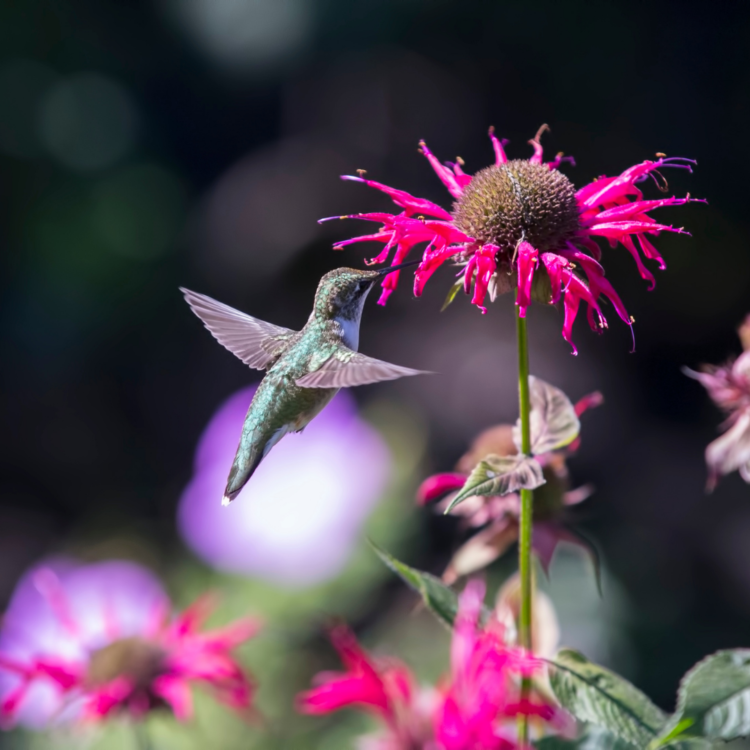
Hummingbirds’ favorite food is pretty obvious: sugar! They are specially adapted to feed on the nectars of flowering plants, which are rich in various kinds of sugars. Additionally, plant nectars may contain trace amounts of other nutrients that are useful to the bird. What kind of nutrients, and what kind of sugars, the flowers contain will depend on the plant species. The key to attracting hummingbirds is creating easy and recognizable sources of this food.
Hummingbird feeders are a great, simple, and easy-to-maintain approach. However, if you want to be sure that your hummingbirds have a healthy diet, it’s worth having flowers as well. As with other tips for wildlife gardening, having native plants, and more species of plants, is the best way to go. Specifically, having a diversity of native flowers means that hummingbirds in your space can access the nutrients that they need from plants from which they are adapted to feed.
Plant your hummingbird flowers and position your feeder in locations where you can watch easily. Giving yourself a good viewpoint will make it easy to enjoy hummingbirds. I recommend also positioning them so that you have options to view from indoors. Any setup where you can be partially hidden will make you less scary to the hummingbirds. Ultimately, this means better views and more exciting behaviors to observe.
Both male and female hummingbirds set up feeding territories where they “own” the flowers within. If you have more available flowers, spread over a larger space, you can have more territories, and more hummers.
Shelter
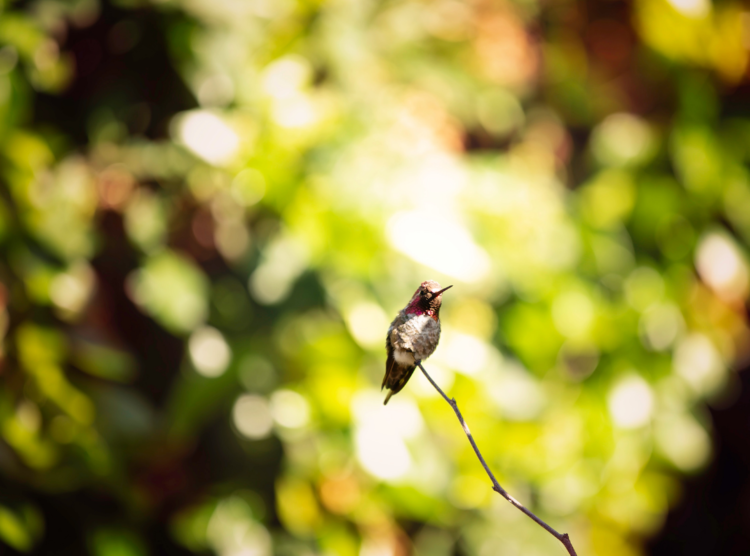
One feature that people commonly neglect in making hummingbird habitat is giving them somewhere to hide. Like other animals, hummingbirds can fall prey to predators. Hummingbirds are vulnerable to bird-eating predators, despite how impossibly fast they seem.
Consequently, they don’t want to have to run a big risk by crossing large, open areas to get to food sources. Having bushes, shrubs, and small tree cover near your flowers and feeders will make hummers feel more safe when visiting. This means you’ll probably have more visitors, and more frequent visits, because there’s less risk for them.
These cover areas also serve another purpose. Specifically, they shelter hummingbirds from the elements. Being small, they are more sensitive to ambient temperature and rainfall than other birds. Hummingbirds do better when they have safe places to sleep, rest, or escape the rain. By providing these resources in addition to food in your yard, you greatly increase your chances of attracting and keeping hummingbirds.
Real estate (Nesting habitat)
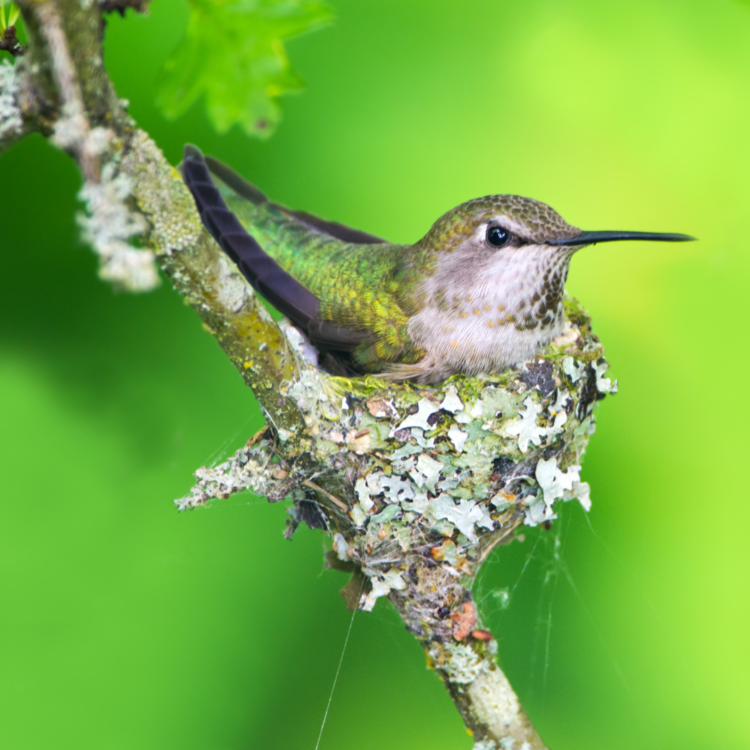
Shelter aren’t the only thing on hummingbirds’ minds when they check out your back yard. As days get longer and warmer, they are increasingly interested in romance. Generally, this becomes a matter of finding a place to make a nest and raise babies. Although nesting habitat depends on your local hummingbird species, they typically nest in shrubs, bushes, and lower branches of trees.
Hummingbirds don’t use birdhouses and rarely nest on human-made structures. Instead, they build adorable little cup nests with spiderwebs, mosses, and lichens. Certainly, having these resources available will help with their homemaking. Since males don’t help with raising young, nesting real estate is important if you want to see females and babies. The flashier males, however, are more interested in setting up feeding territories.
Safety
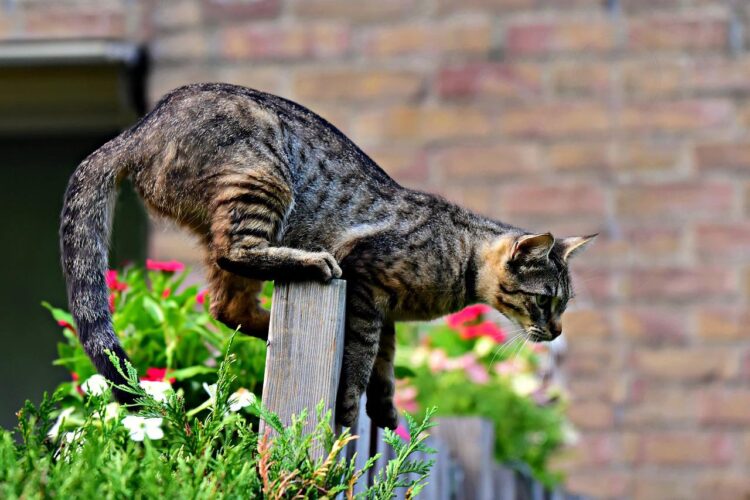
Another key concern for hummingbirds is safety. Many gardens are relatively free of hummingbirds’ natural predators. However, there may be many more predators that hummingbirds aren’t accustomed to. In particular, domestic cats are a major threat. Although they aren’t likely to present a hummingbird on your front footstep, cats kill hummingbirds often. If you want to attract hummingbirds and enjoy them in your yard, you need to take some responsibility, too. Make sure that you don’t have lots of neighborhood cats in your yard. Additionally, you can keep your own cat indoors.
If you have to let your cat outside, consider giving them a highly visible cat collar cover to make them more obvious to birds. Aside from keeping your cat inside, you can also make safe places for hummingbirds to eat. For instance, you can make sure that hummingbird feeders are high up and inaccessible to cats and other predators.
You can do this by hanging them from a tall pole. Alternatively, you could put them on a window that is high up with no surfaces to climb on. The general idea is to find places that are accessible to flying animals but not to walking ones. This may mean getting a ladder to change your feeder, but the hummers’ safety is worth it!
Finally, give hummingbirds a good vantage point. Make sure that there are tall perches, like bare tree branches, where they can keep an eye on your space. This allows them not only to defend a feeding territory but also to keep an eye out for predators. If they know what’s going on, they can take steps to keep themselves safe.
How can I make habitat to attract hummingbirds to my yard?
Attracting hummingbirds with your outdoor space is straight-forward once you know about their habitat needs. Here’s the recap:
- Food – Hummingbird feeders are the easiest approach. However, having several kinds of native flowers around ensures them a well-rounded diet. Place your feeders in open areas where the hummers are likely to find them. Change the food once weekly or every 2-3 days when its especially hot out.
- Shelter – if you can, make sure there are shrubs, bushes, or small trees for hummingbirds to land and hide in. If these are within eyesight of the food source, even better! Hummingbirds like to perch and survey the situation before they go and feed.
- Nesting habitat – If you want to help hummingbird populations thrive, make sure they can nest in your space. Provide some tree cover and hidden-away areas in the foliage where a female can build a nest.
- Safety – Do what you can to keep predators away from your hummingbird feeders. Try to reduce groundcover around feeders or food plants so that cats don’t have a place to hide. Ideally, keep cats indoors. If you can’t, find ways to limit their hunting ability with collars and bells. Make sure that hummingbirds have places to perch where they can keep an eye on things.
What food sources do I use to attract hummingbirds to my yard?
Although I’ll have more on this in future post, here’s a primer on feeders and food plants to delight your hummers’ palettes.
Hummingbird feeders
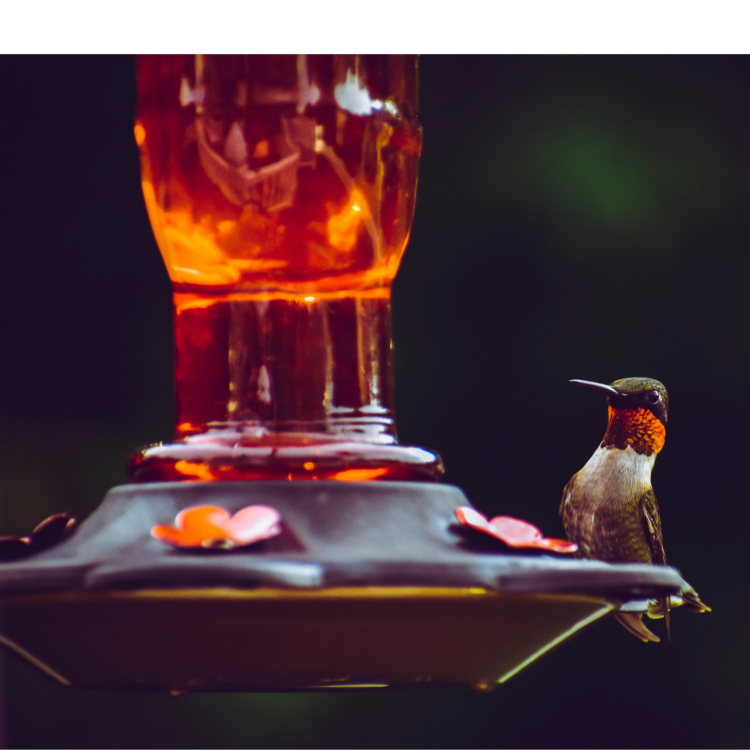
There is a pretty overwhelming variety of hummingbird feeders out there. Generally, I don’t think the shape is that important. Hummingbirds are pretty smart and can figure out food sources quickly. If they have features that resemble flowers, or resemble other hummingbirds, they’ll figure it out even quicker. So I wouldn’t sweat design too much. As long as hummingbirds can perch comfortably on the feeder and have a clean place to drink, the feeder is doing its job.
Keeping feeders clean is another major part of safety for hummingbirds. Feeders that get dirty can quickly accumulate harmful fungi that can make hummingbirds sick. I have heard from multiple wildlife rehab clinics that a major reason for sick and dying hummingbirds is fungi from dirty feeders.
That being said, one thing to think about when choosing a feeder is material and shape. That is, is it an easy-to-clean design? Is the feeder made of materials that will stay cleaner, and are easier to get clean?
Here are some of my recommendations based on material and cleanability:

Monarch Abode Circular Glass Feeder – A simple design that’s easy to take apart and clean. Glass can go through the dishwasher and be thoroughly cleaned at high temperatures.

Perky-Pet Mason Glass Feeder – A higher-volume feeder that is also easy to clean and assemble/disassemble.

BOLITE Diamond-shaped Glass Feeder – Like the model above, has a wide mouth for easier cleaning, and is made of easy-to-clean materials.

BOLITE Red Bottle Glass Feeder – Durable glass material and a simple design, multiple feeding ports and perches.
Feeder hangers

As we went over in the section on safety, where you hang your feeders is important. Placing them up high and in a place where cats can’t reach them is key to keeping hummers safe. Having a tall hanger to place in an open area with perching shrubs or trees within 20-30 feet (6-10m) is a great way to go.
If you have taller trees or other structures that cats may find difficult to climb, a hanging bracket might be a good way to go. Otherwise, free-standing feeder hangers are always a safe bet. I tend to prefer the free-standing ones, since you can put them anywhere. Additionally, you can place them strategically to avoid cats having access. The taller, the better!
Hummingbird plants
As I mentioned, native plants are the best thing that you can do for healthy hummers. That does mean, however, that what flowers you plant will depend on you area. Below, I have listed some common native plants that hummingbirds love in different regions of North America. I based these lists on the ranges of the most common backyard-dwelling hummingbirds in the U.S. and Canada.
Eastern US & Canada
The Ruby-throated hummingbird (Archilochus colubris) is the only common hummingbird East of the rocky mountains. Fortunately, they are widespread and common in forested, suburban and rural areas in the Eastern U.S. and Southeastern Canada. Here are some plants they’ll love:
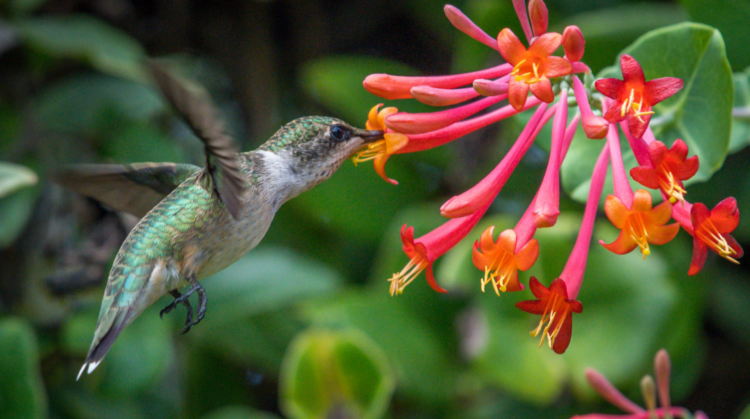
- Trumpet creeper (Campsis radicans)
- Cardinal flower (Lobelia cardinalis)
- Native honeyusuckle (Lonicera sempervirens)
- Jewelweed (Impatiens capensis)
- Bee-balm (Monarda sp.)
- Catnip and Catmint (Nepeta sp.)
- Hosta sp.
The Pacific Coast (especially California)
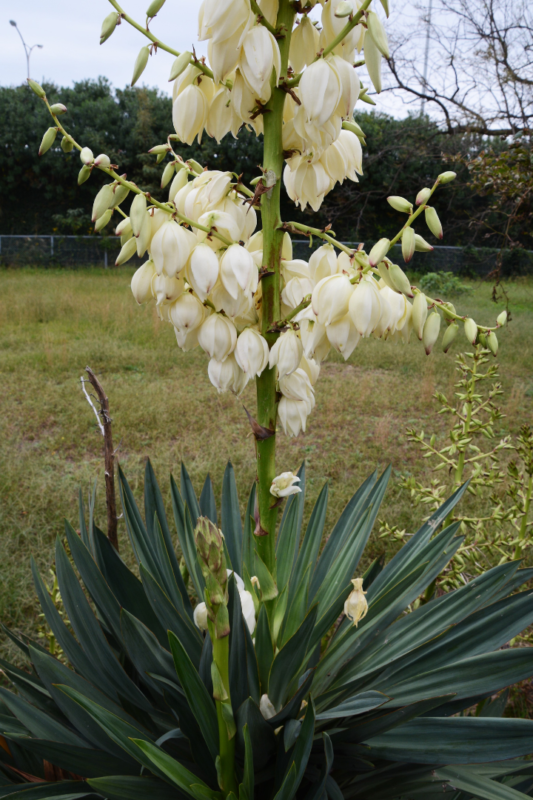
The Anna’s hummingbird (Calypte anna) is the most likely backyard hummer you’ll spot in California. Further south, however, you might run into the Allen’s hummingbird (Selasphorus sasin). These plants will increase your chances of seeing them:
- Manzanita (Arctostaphylos manzanita)
- Eucalyptus – Even though this species is non-native, if you have it on your property already it may be worth taking advantage. Native hummingbirds seem to be drawn to it.
- Milkweed (Asclepias sp.)
- Sage (Salvia sp.)
- California fuchsia (Epilobium canum)
- Monkeyflowers (Mimulus sp.)
- Yucca sp.
The Rocky Mountain & Inland West
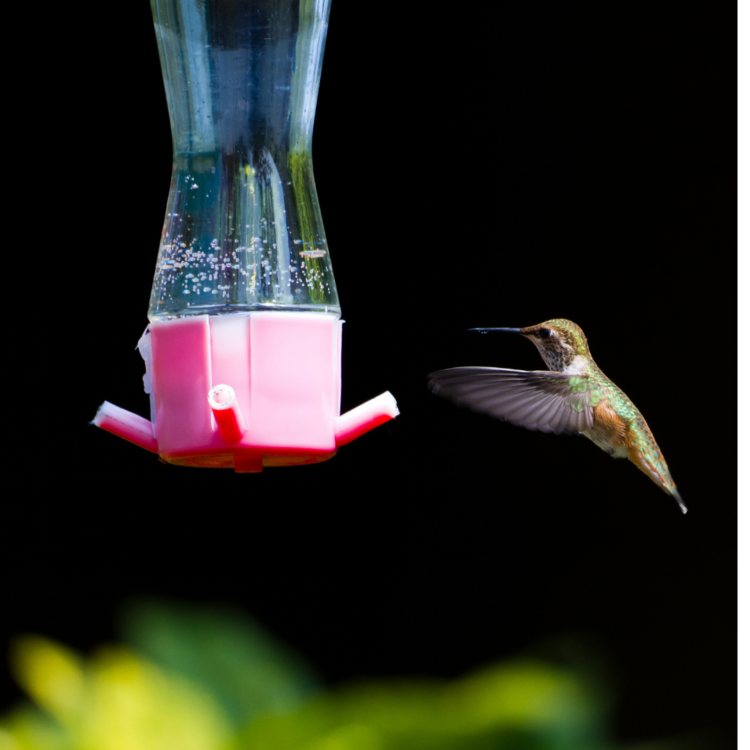
Out in Montana, Wyoming, Utah, and Colorado, you’ll have three main hummingbirds to keep an eye out for. The most common in backyards and gardens is the Rufous hummingbird (Selasphorus rufus). Depending on your location, you might also get the Calliope (Selasphorus calliope) or Black-chinned (Archilochus alexandri) hummingbirds. Although what plants do best is a matter of your local climate, here are some suggestions:
- Columbine (Aquilegia sp.)
- Scarlet gilia (Ipomopsis aggregata)
- Penstemon
- Paintbrush (Castilleja sp.)
- Fireweeds (Chamaenerion angustifolium)
- Currants (Ribes sp.)
Further reading
If you’d like to learn more about hummingbirds, check out these two episodes from the Nature Guys Podcast:
If you’re looking for reading materials, check these out:
Gardening for hummingbirds
- The Art of Hummingbird Gardening: How to Make your Backyard Into a Beautiful Home for Hummingbirds by Mathew Tekulsky
- The Hummingbird Book: The Complete Guide to Attracting, Identifying, and Enjoying Hummingbirds by Lillian and Donald Stokes
Hummingbird Natural History
- North American Hummingbird: An Identification Guide by George C. West
- Hummingbirds of North America by Sheri Williamson and Roger Tory Peterson
- The Hummingbird Handbook: Everything You Need to Know about These Fascinating Birds by John Shewey
Thanks for reading!
As always, if you have other tips or tricks that you’d like to share, let me know in the comments. I’m always looking to answer reader questions, so use the contact page if there are topics you’d like to see in Gulo in Nature.

